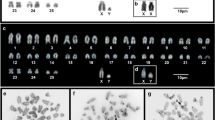Abstract
We present here data on chromosome banding analysis (R- and C-bands) ofAcomys sp. (Rodentia, Muridae) from Oursi, Burkina Faso, characterized by 2n=FN=68 and comparison of its banding patterns with those ofAcomys dimidiatus from Saudi Arabia (2n=38, FN=70), studied previously. The study revealed complete homology between acrocentric chromosomes ofAcomys sp. and chromosome arms of 16 pairs of metacentric and two pairs of acrocentric chromosomes ofA. dimidiatus. In addition to monobrachial homology, one tandem translocation accompanied by a centromeric shift was identified in the karyotype of the latter species. The data obtained show that karyotypes of all the species of theAcomys cahirinus-dimidiatus group studied previously may be derived from that ofAcomys sp. from Oursi by means of numerous non-homologous Rb translocations and 1–2 tandem translocations, and thus its karyotype may be considered as ancestral for thecahirinus-dimidiatus group.
Similar content being viewed by others
References
Corbet GB, Hill JE (1987)A World List of Mammalian Species. London: British Museum (Natural History).
Denys C, Gautun JC, Tranier M, Volobouev V (1994) Evolution of the genusAcomys (Rodentia, Muridae) from dental and chromosomal patterns.Isr J Zool 40: 215–246.
Dippenaar NJ, Rautenbach IL (1986) Morphometrics and karyology of the southern African species of the genusAcomys I. Geoffroy Saint-Hilaire, 1838 (Rodentia: Muridae).Ann Transvaal Mus 34: 129–183.
Ellerman JR (1940–1941)The Families and Genera of Living Rodents. Vol. 2. Muridae. London: Trustees of the British Museum (Natural History).
Garagna S, Broccoli D, Redi CA, Searle JB, Cooke HJ, Capanna E (1995) Robertsonian metacentrics of the house mouse lose telomeric sequences but retain some minor satellite DNA in the pericentromeric area.Chromosoma 103: 685–692.
Gautun JC, Tranier M, Sicard B (1985) Liste préliminaire des rongeurs du Burkina Faso (ex Haute Volta).Mammalia 49: 537–542.
Musser GG, Carleton D (1993) Family Muridae. In: Wilson DE, Reeder DAM, eds.Mammal Species of the World 2nd edn. Washington, DC: Smithsonian Institution Press, pp 501–755.
Nanda I, Schneider-Rasp S, Winking H, Schmid M (1995) Loss of telomeric sites in the chromosomes ofMus musculus domesticus (Rodentia: Muridae) during Robertsonian rearrangements.Chrom Res 3: 399–409.
Petter F (1983) Eléments d'une révision desAcomys africains. Un sous-genre nouveau,Peracomys Petter et Roche, 1981 (Rongeurs, Muridés).Ann Mus R Afr Cent Sci Zool 237: 109–119.
Searle JB (1993) Chromosomal hybrid zones in Eutherian mammals. In: Harrison RG, ed.Hybrid Zones and Evolutionary Process. Oxford University Press.
Searle JB, Hübner R, Wallace BMN, Garagna S (1990) Robertsonian variation in wild mice and shrews.Chrom Today 10: 253–263.
Sokolov VE, Orlov VN, Baskevich MN, Mebrate A (1992) Chromosomal set of the spiny miceAcomys (Rodentia, Muridae) along the Ethiopian Rift Valley.Zool Zhurnal (Moscow) 71: 116–124.
Sumner AT (1972) A simple technique for demonstrating centromeric heterochromatin.Exp Cell Res 75: 304–306.
Viegas-Péquignot E, Dutrillaux B (1978) Une méthode simple pour obtenir des prophases et des prométaphase.Ann Génét 21: 122–125.
Volobouev V, Tranier M, Dutrillaux B (1991), Chromosome evolution in the genusAcomys: chromosome banding analysis ofAcomys cf. dimidiatus (Rodentia, Muridae).Bonn Zool Beitr 42: 253–260.
Volobouev VT, Gautun JC, Tranier M (1996) Chromosome evolution in the genusAcomys (Rodentia, Muridae): I. Chromosome banding analysis ofAcomys cahirinus.Mammalia 60: 217–222.
Zambelli A, Vidal-Rioja L (1995) Molecular analysis of chromosomal polymorphism in South American cricetid,Graomys griseoflavus.Chrom Res 3: 361–367.
Author information
Authors and Affiliations
Corresponding author
Additional information
accepted for publication by M. Schmid
Rights and permissions
About this article
Cite this article
Volobouev, V., Gautun, J.C., Sicard, B. et al. The chromosome complement ofAcomys spp. (Rodentia, Muridae) from Oursi, Burkina Faso—the ancestral karyotype of thecahirinus-dimidiatus group?. Chromosome Res 4, 526–530 (1996). https://doi.org/10.1007/BF02261780
Received:
Revised:
Accepted:
Issue Date:
DOI: https://doi.org/10.1007/BF02261780




